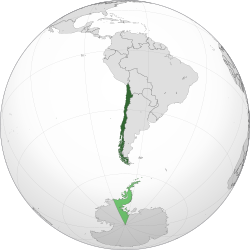
Back تحول تشيلي نحو الديمقراطية Arabic Transition in Chile German Transición a la democracia en Chile Spanish گذار به دموکراسی در شیلی Persian Transition chilienne vers la démocratie French Transición á democracia en Chile Galician היסטוריה עכשווית של צ'ילה HE
This article has multiple issues. Please help improve it or discuss these issues on the talk page. (Learn how and when to remove these template messages)
|
Republic of Chile República de Chile | |||||||||
|---|---|---|---|---|---|---|---|---|---|
| Motto: Por la razón o la fuerza ("By reason or by force") | |||||||||
| Anthem: Himno Nacional de Chile ("National Anthem of Chile") | |||||||||
 | |||||||||
| Capital | Santiago | ||||||||
| Common languages | Spanish | ||||||||
| Government | Unitary presidential constitutional republic | ||||||||
| President | |||||||||
• 1990–94 | Patricio Aylwin first | ||||||||
• since 2022 | Gabriel Boric current | ||||||||
| Establishment | Return to democracy | ||||||||
• Established | 11 March 1990 | ||||||||
| Population | |||||||||
• 1990 | 13,178,782 | ||||||||
• 2017 | 17,574,003 | ||||||||
| Currency | Chilean peso | ||||||||
| ISO 3166 code | CL | ||||||||
| |||||||||
| History of Chile |
|---|
 |
| Timeline • Years in Chile |
On 11 March 1990, Chile the military regime of General Augusto Pinochet ended and was replaced by a democratically elected government.[1] This transitional period lasted roughly two[2] years although some processes may have lasted significantly longer. Unlike most democratic transitions led by either the elite or the people, this democratic transition process is known as an intermediate transition[1] – a transition involving both the regime and the civil society.[3] Throughout the transition, as the regime increased repressive violence, it simultaneously supported liberalization – progressively strengthening democratic institutions[4] and gradually weakening that of the military.[5]
There are three factors that contributed to the rise of democracy:[6] the economy, the role of the military, and domestic politics. Rapid economic growth (attributed to a low inflation environment), a decline in dictatorship, and the decision of political parties to come together became the main motivation for a broad ideological coalition to be created in an effort to defeat Pinochet and his military rule.[7] Chile was previously a democracy during the Presidential Republic (1925–1973).
The preparation for the transition began within the dictatorship itself when a Constitution establishing a transition itinerary was approved in a plebiscite. From 11 March 1981 to March 1990, several organic constitutional laws were approved, leading to the final restoration of democracy. After the 1988 plebiscite, the 1980 Constitution (which is still in effect today) was amended to ease provisions for future amendments to the constitution, create more seats in the senate, diminish the role of the National Security Council, and equalize the number of civilian and military members (four members each).
Christian Democrat Patricio Aylwin served from 1990 to 1994 and was succeeded by another Christian Democrat, Eduardo Frei Ruiz-Tagle (son of Eduardo Frei Montalva), leading the same coalition for a six-year term. Ricardo Lagos Escobar of the Socialist Party and the Party for Democracy led the Concertacion to a narrower victory in the 2000 presidential election. His term ended on 11 March 2006, when Michelle Bachelet of the Socialist Party took office.[8] Center-right businessman Sebastián Piñera, of National Renewal, assumed the presidency on 11 March 2010, after Bachelet's term expired. Bachelet returned to the office on 11 March 2014, being succeeded by Piñera in the following term (2018–2022).
Today, Chile is ranked 29 in the current democracy index.[9]
- ^ a b Scott, Sam (2001). "Transition to democracy in Chile | two factors". ScholarWorks: 12.
- ^ "Chile: Period of democratic transition: 1988–1989, Pro-democracy civic movement: present" (PDF). Freedomhouse.
- ^ Clark, William; Golder, Matt; Golder, Sona. Foundations of Comparative Politics. p. Chapter 7.
- ^ Plaistad, Shandra. "Chileans overthrow Pinochet regime, 1983–1988". Global Nonviolent Action Database.
- ^ Geddes, Barbra (1999). "What Do We Know About Democratization After Twenty Years?". Annual Review of Political Science. 2: 7. doi:10.1146/annurev.polisci.2.1.115.
- ^ HUTCHINSON, OLIVIA. "Transitioning to Democracy: The Role of the Right in Chile and Argentina". E-International Relations. University College London.
- ^ Angell, Alan; Pollack, Benny (1990). "The Chilean Elections of 1989 and the Politics of the Transition to Democracy". Bulletin of Latin American Research. 9 (1): 1–23. doi:10.2307/3338214. JSTOR 3338214.
- ^ "Background note". Department of State.
- ^ "Ranking of Countries by Quality of Democracy". Democracy matrix.
© MMXXIII Rich X Search. We shall prevail. All rights reserved. Rich X Search

